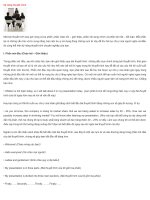thuyết trình 73 VHF GMDSS
Bạn đang xem bản rút gọn của tài liệu. Xem và tải ngay bản đầy đủ của tài liệu tại đây (1.89 MB, 19 trang )
mu
s
are all vessels engaged on
international voyages, except:
- very small vessels,
- vessels that are not self-propelled,
- and men-of-war.
Radio-Telephony (RTF)
Digital Selective Calling (DSC)
Direct Printing Telegraphy (DPT)
Navigational Telex (NAVTEX)
Search and Rescue Radar Transponder (SART)
for short distances in territorial waters and inland waterways.
“simplex” radio:
speaking and listening cannot be done
simultaneously.
“duplex” radiotelephone:
speaking and listening can be done
simultaneously.
“semi-duplex” installations:
simultaneous speaking and listening,
but receiving-end has simplex-installation.
DSC digitally announces and initiates ship/ship,
ship/shore, and shore/ship radiotelephoneand radiotelex calls.
After the announcement has been digitally
acknowledged by the receiving station or ship,
communication is usually continued by RTF.
A DSC distress-alert consists of a preformatted
distress message.
Natures of distress that can be entered are:“fire/explosion”,
“flooding”, “collision”, “grounding”, “listing”, “sinking”,
“disabled and adrift”, “piracy” and “undesignated distress”.
Distress alerts are automatically addressed
to all stations with the distress-button
(indicated by SOS, ALARM, EMER or DISTRESS).
Urgency, safety and routine calls can be addressed
to all stations or ships, an individual station or ship,
or a group of stations or ships.
A DSC-installation on board a vessel or at a
coast station has a unique nine-digit identification
number (MMSI), pronounced on VHF in groups of 3.
It is sent automatically with each DSC-transmission.
The first three digits of the MMSI are the
Maritime Identification Digits (MID)
representing the country of registration.
Inmarsat,
COSPAS/SARSAT,
Emergency Position Indicating
Radio Beacons (EPIRBs),
Status Recording-system (STAREC).
Communication by means of the
geostationary Inmarsat-satellites
extends in an area between
70 degrees latitude North and
70 degrees latitude South.
The 4 Inmarsat-regions:
- Atlantic Ocean Region West (AOR-W);
- Atlantic Ocean Region East (AOR-E);
- Indian Ocean Region (IOR);
- Pacific Ocean Region (POR).
NAVTEX is a telex-receiver/printer installed
on GMDSS-vessels to receive
Maritime Safety Information-messages (MSI).
These navigational messages are addressed
“to all vessels” and contain information concerning
meteorological warnings, SAR-operations and
other important and urgent data.
An EPIRB will be released from the vessel-in-distress
by hand, or automatically by a hydrostatic release
mechanism.
It will be activated automatically and will start
to transmit a distress alert to Rescue-Coordination
s
Centres via satellite, giving position and identification
of the vessel.
EPIRB
SART
A SART will transmit an alert that will create
a series of dots on the radar display of a
Search & Rescue-Unit that will then have the
means to locate the distressed raft or vessel.
s
Unlike the Inmarsat-satellites,
COSPAS/SARSAT satellites are not
geostationary, but orbit the earth
on a North/South- and
South/North path.
s
C P.C. van Kluijven
SHIPPING AND TRANSPORT COLLEGE ROTTERDAM









